Quite recently I’ve seen a lot of organisations or individual professionals who train animals, promoting themselves and what they do as being “force-free.”
I thought it might be useful to examine what might be meant by force-free and to attempt to define it more specifically.
The challenge is, that when it comes to behaviour science and animal training, there is no scientifically agreed definition of the terms “force” or “force-free”. These terms do not exist in behaviour change science, and do not have a “standard” agreed definition in any scientific work that relates to animal keeping or training that I can find. If you think you have found one, please let us know.
If someone says they are “force-free” or that they don’t use any force in their training, all it really means is that they believe that what they are doing or teaching others to do does not involve force. It’s all a matter of opinion, and as we know, opinions differ.
So I am going to share my opinion of what constitutes force when it comes to keeping and training animals. You are welcome to agree or disagree because, like I said, it is a matter of opinion.
It’s probably worth saying that I have yet to achieve the goal of keeping my own horses in a way that is 100 per cent force-free. I’ve literally moved to another country in order to be able to keep them at home and to maximise my chances of being able to operate their living space and their handling and training without any form of compulsion. But I am not always successful.
I keep track of how many days we’ve been able to operate without actually using a halter and lead rope or where we’ve been able to meet their needs and look after them without any compulsion or fear, frustration or apparent stress. At least then I know I am making progress.
The fact that I keep my horses in paddocks surrounded by electric fencing, while we figure out how best to use the grazing here is a major concern to me, and something I spend lots of time agonising over! But that is a short term issue while we rearrange the land and repair damage to fences and gateways and build a holding area for winter, and get onto a rotational system and learn how best to use the resources we have.
When I fail I learn. It causes me to evaluate whether I could have set up the environment better, or done more desensitisation training (not that you can ever do too much) or picked a different time of day, or got someone to help me.
The key I have found though, is to have a clear idea in our own mind about what constitutes force or forceful handling or forceful animal-keeping or training, so as to be very mindful of it when planning on doing things with our animal friends.
I may not go many days that involve what I would consider to be true zero force at the moment, but zero force is my goal.
I believe it’s achievable and that if we adopt a mind-set that is about having a strong intent to be zero-force then it causes us as owners to behave differently. If I approach a situation thinking, “How can I do this without needing to rely on using force?” I believe I will be much more likely to take action to reduce or eliminate the need for it.
The attitude or belief that “using force is inevitable and unavoidable” can cause us to lower our standards and aspirations and to make excuses when the reality is it is often our own lack of planning or forethought that gets us into situations that require the use of force.
Meanwhile let’s turn attention to how we might specifically define force.
Based on my own personal cogitations and explorations into the subject, I would currently define force as follows:
1) When an animal is put under / subjected to an aversive stimulus until it does a behaviour desired by the handler or rider.
This would ordinarily be described as pressure-release / pressure-relief / negative reinforcement. Technically, negative reinforcement describes what is said to have happened when a behaviour increases in frequency as the result of the removal, or the reduction in the strength of an aversive stimulus.
However, in order for a behaviour to be negatively reinforced, there has to be an aversive stimulus applied, (or the animal has to believe one will be applied) to produce or prompt the behavioural response in the first place. So to give it a complete description I prefer to talk about “aversive stimulation with negative reinforcement” to make it clear that the behaviour has been produced in response to some aversive trigger or predictor.
I regard this as using force, because the animal is subjected to some unpleasant, annoying, uncomfortable or painful stimulus, or kept in a situation in which s/he is uncomfortable, anxious or stressed until s/he performs some approximation of a correct behaviour. At which point the handler or rider attempts to provide relief from that situation.
The information this gives to the horse is “you will experience this unpleasantness until you behave differently”.
This is the core method being used in all forms of “natural horsemanship” training. It’s often described as the method used in traditional training, but my own observations are that this is rarely the case.
Unfortunately I usually see aversives / pressure being applied and removed with little regard to the behaviour being performed. Pressure comes on and off and on and off, sometimes without any understanding of the need for aversive removal for reinforcement, and aversives are not necessarily (if ever) reduced or removed when the horse does what the handler or rider wants.
Many folk who are riding traditionally or who are trying to emulate high level riders in equestrian sports seem to me to want to have the horse permanently held in what must be after a short time an uncomfortable “frame” as a means of restraint, with little relief from pressure on the bit or noseband. I am all for horses moving correctly but this can be achieved using either positive or negative reinforcement without the need to hold the head of the horse in place.
2) When an animal is put under / subjected to aversive stimulation until it ceases to perform a behaviour that the handler wants it to stop doing. This would ordinarily be considered to be and referred to as a “correction”.
This form of force can only be referred to as positive punishment if the behaviour has measurably decreased in frequency if the same conditions occur in the future. Very often this doesn’t happen. The reason it doesn’t happen is because as a method of compelling a horse to stop performing a behaviour, it fails to address the reasons why the horse was performing that behaviour in the first place.
Correcting (smacking, admonishing, scolding, lead rope yanking, or burning with your cigarette end – I have recently been speaking with a client in the UK who shows horses, who was advised to do this by a judge) does not change how the horse feels about the trigger stimulus or event that caused him to choose to bite you.
3) Use of manipulation (picking up the animal or using any device attached to the animal) to move all or part of a resisting or protesting or shutdown (learned helpless) animal into a place or position the handler wants.
That would include the use of 1) or 2) combined with manipulation / physical manhandling.
I stress that I regard this as force if the animal shows aversion (resists, moves away, tries to move a handler away from themselves or resigns / submits), because it is very possible to touch or pick up or otherwise manhandle an animal without them finding this aversive and without them complying in order to be released.
There is a big difference between co-operation and consent. A horse may co-operate with, for instance, their legs being held onto and pulled around by a trimmer or farrier if their “co-operation” has been negatively reinforced by being released from being handled or restrained. If we are holding the foot of a horse and the horse resists or struggles a little bit (or a lot!) and we only let go when the horse relaxes, or “yields”, then that would be flooding, with negative reinforcement, if the horse became more likely to comply in the future.
But this is very different to the horse participating and consenting. The horse who is restrained (prevented from moving away) and “forced” to have his foot held until he relaxes it and who gets “better” at having her feet done in future for this reason is probably complying but not necessarily consenting.
To teach an animal that they have the choice and the chance to give consent, we have to make sure they are agreeing to being touched or held onto in the first place and we must let go when they resist, or when they otherwise indicate that they want us to let go.
I am all for a farrier or trimmer holding onto a horse’s foot if they are in the middle of trying to remove a shoe and there is a risk of injury to person or horse from shoe or nails if they were to let go. I just think that unless it is a genuine emergency, they probably should not be trying to remove shoes from an animal that is likely to struggle in the first place. For their own safety. And that it’s our responsibility to train the animal for this predictable situation, so that we don’t put our farriers or trimmers at risk.
4) Restraint. Preventing the voluntary and desired physical movement of all or part of an animal either by a person holding onto the animal or leaving the animal attached to a fixed object or leaving the animal wearing a device that prevents voluntary movement of all or part of the body. Including attaching to the animal any rope, harness, collar and lead, head collar and rope, bitless or bitted bridle, martingale, draw reins, (and any other reins or head-gear attachments designed to restrict movement) hobbles, tethers or jesses.
For many animals restraint is aversive in and of itself. Just because an animal ceases to try to be free of restraint does not indicate acceptance. If anything this is much more likely to be indicative of learned helplessness – a condition in which the animal ceases to seek to escape an inescapable aversive situation.
Again, like manhandling and manipulation, it is possible to restrain an animal with their consent with careful desensitisation and counter-conditioning and / or positive reinforcement.
5) Routine and prolonged confinement of a healthy animal in a cage, crate, stable, trailer, horse box, round pen or yard, car, kennel.
Use of any construction designed to restrict or deny freedom of movement.
If we thinking about the ethology of the horse, and from the point of view of the horse, we would never assume that any horse would initially feel safe being contained in a small space, or to be isolated from others.
Sometimes we choose to keep horses in stables, pens, stalls and so on, for their longevity or comfort.
Perhaps because they would get laminitic on unlimited grass, or be miserable in heat and flies. But there is ample evidence that prolonged physical confinement is detrimental to the emotional and physical well being of horses.
I firmly believe that it is essential to train horses for confinement in the event that they have to be kept stabled, stalled or in a small outside yard or small pen for medical reasons, where movement must be restricted or where controlled exercise is prescribed.
I am also a strong advocate of training them to handle being travelled and separated is also important, should they need to be transported to a vet. But I also recommend that this must be done in advance, and I believe this can be done on a gradual basis, associating short periods of confinement with good things happening.
But we all have emergencies! And that’s where the final paragraphs of my definition of force are as important as the rest. So please read on to the end of this article if you are feeling judged about your occasional use of force or for keeping your horses confined for some of the time. There are good and legitimate reasons to keep horses confined in some circumstances and training them for confinement, but it will require some exposure to being confined to be associated with something they really like.
The ideal would be to give them the choice when it comes to shelter from heat, flies, wind, snow and ice or mud. Sometimes we personally wish we had much more say and choice of how they are turned out to graze and we wish our horses had more say in whose company they keep. When it comes to confinement and horse keeping, sometimes we have to do the best we can with what resources we have.
When I had my horses at livery I am certain that they both suffered far more from being out without any shelter in summer than they ever did stabled over night of the muddy fields in winter. But that’s just my opinion!
6) Exposing the animal to a feared stimulus, event or situation while preventing escape either through confinement or restraint or correction, until the animal ceases to seek to escape and appears to calm down or give up.
This is more commonly known as flooding. It’s extremely commonly used – and often done in conjunction with negative reinforcement – the animal is released only when they appear to be calm or calmer – and punishment – the animal is corrected for trying to escape.
Where correction or “response prevention” methods are used, in which aversives are added (bit or halter pressure or whip taps on the chest given to stop the horse from going forward or to make the horse back up, rather than go forward in flight) to prevent attempts to escape, this can result in conditioned suppression.
7) The use of food to lure animals into confinement or that results in restraint or aversive handling.
This may seem an odd one. But for a force-free trainer there are few things as difficult to deal with as an animal who has been entrapped with food. It associates an unpleasant experience with the appearance of food, and can seriously impair the efforts of any trainer to use food from people for counter-conditioning purposes.
8) Withholding access to food in an effort to build an appetite or hunger. This is sometimes used by trainers to create motivation to do a behaviour the animal has previously resisted or is expected to resist, because we know that deprivation creates motivation to satisfy the animal’s innate needs (for forage, friends or freedom – depending on the species). This can put the animal into an approach-avoidance conflict situation where they have to choose between something they need (food) and something they don’t want to do.
Contrary to popular belief – ethical positive reinforcement trainers would never withhold food from an animal to produce motivation to behave for food. It remains a common practice, referred to as “weight management” amongst some bird trainers, and a practice that is being challenged by advocates for force-free training such as Barbara Heidenreich.
But as far as our organisation is concerned, our instructors actively encourage people to try to always have the horse’s normal source of fibre forage available (grass or hay) when training horses because of the nature of the digestive system of equines as trickle feeders. We also find that this mitigates the risk of conflict, particularly with horses whose owners are making the transition from aversive methods or where the horse has become sensitised to and is fearful of people, places and things.
9) Making access to food (or indeed friends or freedom) contingent on enduring a feared stimulus.
This means making food available only if the animal approaches or stays close to a feared stimulus.
This is different to using food for counter-conditioning. When we use food for counter-conditioning purposes, the animal does not have to “behave” to get the food.
What I am referred to here are some uses of positive reinforcement to “encourage” animals to approach or touch feared stimuli. This can create emotional conflict, and in many situations the use of habituation techniques or a structured programme of systematic desensitisation (graduated exposure) and counter-conditioning (pairing a very mild aversive stimulus with something the animal finds very desirable) would be a preferable solution.
10. Yeah, but!
I hear you! Your wails of “Yeah but!” and “What if….?” are loud and clear and coming from all around the globe!
I can hear your fingers on the keyboard as you compose your retort of “So, are you expecting us to let our horses just walk out in front of traffic because to prevent that would be a form of force?”
To quote our coach Vikki Spit, “No we aren’t. And if any other of our friends walked out in front of a car, we’d push or pull them out of the way as well.”
In the end we do what we have to do for the horse. But if you have a horse in a situation in which they aren’t trained yet with positive reinforcement at all, or they aren’t responding to the cues you have trained with positive reinforcement, then ideally it’s preferable to stay away from roads. Because whenever you apply an aversive stimulus – pressure – to stop or to produce a behaviour, you run the risk of the animal associating that with anything in the environment that she is responding to, through the process of classical conditioning. And you risk potentially sensitising the horse to traffic by associating its approach with something that the horse finds unpleasant.
I’ve just been talking to a student of mine who has a new horse, and one of her first observations about him was that “He doesn’t know anything!”
By this she means that she has no behaviours trained with him at all, he has not been desensitised to being hosed with water, and yet she is having to currently handle him in and out of a stable and try to cold-hose some wounds he gained on his journey to her yard.
The reality is that we can all get into situations for which we are unprepared or for which the horse is untrained.
When we are in those situations we often think we have no option but to use either medical sedation or aversive means of control, restraint or confinement. Very often we are right, and when there really is no other option then I’d be the first to recommend restraint or negative reinforcement if it were essential to get something done for the good of the horse.
But sometimes we also need to use our imagination so that we don’t feel like we have no choice but to use force.
I am very proud of my student – especially as she is a new horse owner – that she had the imagination to get the help of some people to scratch the horse all over while she examined his wounds.
Until we have some behaviours trained with positive reinforcement, or we find a place to keep them where they don’t really need to be handled at all, then if we have to make a behaviour happen, or do something for the horse where – for their own immediate safety or medical treatment – consent is not really an option, then I’d say that when all else has failed, then some form of force may well have to be our choice.
I can easily justify the use of force on a temporary or occasional basis, where the animal would suffer if we didn’t, or to bring the animal’s suffering or distress to an end sooner.
But I also think we need to use our imagination and resources much better to demonstrate that we’ve exhausted the options available to us in terms of how we keep the animal and organise his environment, and to prevent the animal from being at risk of, or coming to emotional or physical harm in the first place.
Avoiding the need for forceful handling probably comes down to us having learned strategies to prevent and avoid it, and to cultivating a much more active imagination!


















You must be logged in to post a comment.